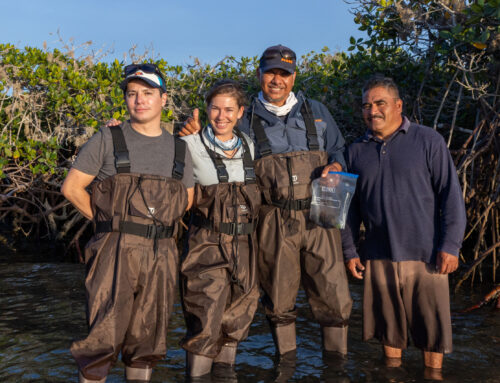Unlocking Nature’s Climate Superheroes in Mexico’s Mangroves.
While reducing emissions and transitioning to renewable energy sources are crucial, a lesser-known hero in the battle against global warming is emerging: Blue Carbon. Carbon is stored in various ecosystems, including forests, grasslands, and wetlands. Blue carbon refers to the carbon captured and stored by coastal and marine ecosystems, primarily mangroves, seagrasses, and salt marshes. These ecosystems excel at absorbing and storing atmospheric carbon dioxide (CO2), making them powerful allies in the fight against climate change. Mangroves in particular possess an extraordinary capacity to store carbon. Their dense root systems trap and store carbon dioxide, often burying it deep in the sediments below. This carbon can remain locked away for centuries or even millennia, preventing its release into the atmosphere where it would contribute to global warming. In fact, mangrove forests can store 4 times as much carbon as a tropical rainforest.
Approximately 4% of the world’s mangroves are found in Mexico. Mexico is home to extensive mangrove forests along its coasts, particularly along the Gulf of California, the Yucatan Peninsula, and the Pacific Ocean. These mangroves play a crucial role in providing habitat for diverse species, protecting coastal areas from erosion, and sequestering carbon dioxide from the atmosphere. Their conservation and restoration are essential for maintaining coastal ecosystems and mitigating the impacts of climate change.

MarVivo is pioneering a blue carbon project in Magdalena Bay on the Pacific Coast of Baja California Sur, conserving 22,000 hectares of pristine mangrove forest from unsustainable aquaculture that drives mangrove deforestation in the Northwest Pacific region.
MarVivo’s Magdalena Blue Carbon Project adopts an integrated approach that combines scientific research, community engagement, and sustainable economic development. By involving local communities and stakeholders, the project ensures that the benefits of blue carbon conservation are shared equitably while promoting socio-economic resilience, preserving biodiversity, improving water quality, and enhancing resilience to extreme weather events.
Blue carbon offers a powerful nature-based solution to climate change, with Mexico’s mangrove forests playing a vital role in carbon sequestration and coastal ecosystem conservation. The Magdalena Blue Carbon Project stands as a pioneering example of how local communities, scientific expertise, and environmental for-profit businesses can collaborate to protect these invaluable ecosystems while combating climate change.
Share This Story, Choose Your Platform:
About The Author:
Tom Sparke
Related Posts

